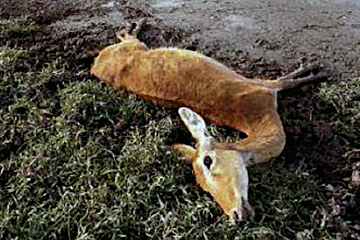A recent, well-covered study found that African mammals populations are in steep decline in the continent’s protected areas. Large mammal populations over forty years have dropped by 59% on average in Africa [read an interview on the study here] and by 85% in west and central Africa, according to the study headed by Ian Craigie, which links the decline to continuing habitat degradation as well as hunting and human-wildlife conflict. However, a new opinion piece in mongabay.com’s open access journal Tropical Conservation Science argues that this study missed an important factor in central and west Africa where the decline in mammals was the worst: rainfall.
“Rainfall is the main abiotic (i.e. non-living) factor determining ungulate grazer populations across Africa […] In West-Central Africa, 1970 was a turning point in terms of natural conditions for most large mammal populations, with their subsequent decline having been triggered by a prolonged decline in rainfall, coinciding with increased human pressure. When rainfall improved, human pressure lifted only partially,” the author, Paul Scholte, writes. Concluding that mammal populations in west-central Africa were abnormally high in the 1970s—the starting point of Craigie’s study— Scholte writes that this “[explains] part, but certainly not all, of the reported 85% decline”.
 A dead kob antelope in Waza National Park in Cameroon. A dam upstream led to a crash in the kob population from 20,000 to 5,000. Photo by: Paul Scholte. |
Examining11 protected areas in West Africa (as opposed to 35 in the south and 43 in the east) is also “too limited a number for the broad conclusions made by the authors regarding the collapse of its large mammal populations,” writes Scholtes, “moreover, their selection was biased towards the west of West-Central Africa, thereby accentuating the decline […] The only [protected area] from Central Africa included, Waza National Park in Cameroon, is exceptional because of the construction of an upstream dam.”
Other studies in Central Africa have shown declines, but not as steep as those presented in the Craigie study. However, a study of five protected areas in the Central African Republic was close, finding a decline of 65%.
Scholte states that the most effective way to deal with these mammal losses is to close the gap between existing funding and the funding required to actually run the parks effectively. According to a 2003 study parks in the regions are underfunded by 90%.
“The few quantitative studies available suggest that a 3- to 10-fold increase in the operational budget of African [protected areas] is required. In addition to up-scaling the funding, a dramatic increase in the (institutional, human, and local) capacity to handle such up-scaled support would be necessary,” Scholte writes.
CITATION: Scholte, P. 2011. Towards understanding large mammal population declines in Africa’s protected areas: A West-Central African perspective. Tropical Conservation Science Vol. 4 (1):1-11.
Related articles